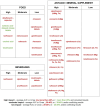Together or Apart? Revealing the Impact of Dietary Interventions on Bioavailability of Quinolones: A Systematic Review with Meta-analyses
- PMID: 38807006
- PMCID: PMC11222276
- DOI: 10.1007/s40262-024-01377-0
Together or Apart? Revealing the Impact of Dietary Interventions on Bioavailability of Quinolones: A Systematic Review with Meta-analyses
Abstract
Background and objective: Managing drug-food interactions is essential for optimizing the effectiveness and safety profile of quinolones. Following PRISMA guidelines, we systematically reviewed the influence of dietary interventions on the bioavailability of 22 quinolones.
Methods: All studies describing or investigating the impact of food, beverages, antacids, and mineral supplements on pharmacokinetic parameters or pharmacokinetic/pharmacodynamic indices of orally taken quinolones were considered for inclusion. We excluded reviews, in vitro and in silico studies, studies performed on animals, and those involving alcohol. We performed the search in Medline (via PubMed), Embase, and Cochrane Library, covering reports from database inception to December 2022. We used the following tools to assess the risk of bias: version 2 of the Cochrane risk-of-bias tool for parallel trials, the Cochrane risk-of-bias tool for cross-over studies, and the NIH quality assessment tool for before-after studies. We performed quantitative analyses for each quinolone if two or more food-effect studies with specified and comparable study designs were available. If meta-analyses were not applicable, we qualitatively summarized the results.
Results: We included 109 studies from 101 reports. Meta-analyses were conducted for 12 antibiotics and qualitative synthesis was employed for the remaining drugs. Of the studies, 60.5% were open-label, cross-over, as recommended by FDA. We judged 46% of studies as having a high risk of bias and only 4% of having a low risk of bias. Among 19 quinolones with available food impact data, 14 (74%) had potentially clinically important interactions. For nalidixic acid, oxolinic acid, and tosufloxacin, food exerted a high positive impact on bioavailability (AUC or Cmax increased by > 45%), whereas, for all the remaining drugs, postprandial absorption was lower. The most significant negative influence of food (AUC or Cmax decreased by > 40%) occurred for delafloxacin capsules and norfloxacin, whereas the moderate influence (AUC or Cmax decreased by 30-40%) occurred for nemonoxacin and rufloxacin. All 14 analysed quinolones showed a substantial reduction in bioavailability when co-administered with antacids and mineral supplements, except for calcium preparations. The impact of beverages was evaluated for 10 quinolones, with 50% experiencing significantly reduced absorption in the presence of milk (the highest negative impact for ciprofloxacin). Moreover, both ciprofloxacin and levofloxacin demonstrated compromised bioavailability when consumed with orange juice, particularly calcium-fortified.
Discussion: Several factors may influence interactions, including the physicochemical characteristics of quinolones, the type of intervention, drug formulation, and the patient's health status. We assessed the quality of evidence as low due to the poor actuality of included studies, their methodological diversity, and uneven data availability for individual drugs.
© 2024. The Author(s).
Conflict of interest statement
The authors have no competing interests to declare that are relevant to the content of this article.
Figures



Similar articles
-
The Impact of Dietary Interventions on the Pharmacokinetics of Antifungal Drugs: A Systematic Review with Meta-analyses.Clin Pharmacokinet. 2025 Jun;64(6):815-848. doi: 10.1007/s40262-025-01511-6. Epub 2025 May 10. Clin Pharmacokinet. 2025. PMID: 40347349
-
Clinically important interactions of macrolides and tetracyclines with dietary interventions-a systematic review with meta-analyses.J Antimicrob Chemother. 2024 Nov 4;79(11):2762-2791. doi: 10.1093/jac/dkae315. J Antimicrob Chemother. 2024. PMID: 39254058 Free PMC article.
-
Do dietary interventions exert clinically important effects on the bioavailability of β-lactam antibiotics? A systematic review with meta-analyses.J Antimicrob Chemother. 2024 Apr 2;79(4):722-757. doi: 10.1093/jac/dkae028. J Antimicrob Chemother. 2024. PMID: 38334389 Free PMC article.
-
Safety and clinical pharmacokinetics of nemonoxacin, a novel non-fluorinated quinolone, in healthy Chinese volunteers following single and multiple oral doses.Clin Drug Investig. 2012 Jul 1;32(7):475-86. doi: 10.2165/11632780-000000000-00000. Clin Drug Investig. 2012. PMID: 22650326 Clinical Trial.
-
Navigating through chemometrics: Unveiling antibiotic-food interactions for improved pediatric formulations ahead.Eur J Pharm Biopharm. 2025 Mar;208:114652. doi: 10.1016/j.ejpb.2025.114652. Epub 2025 Jan 26. Eur J Pharm Biopharm. 2025. PMID: 39875059
Cited by
-
The Impact of Dietary Interventions on the Pharmacokinetics of Antifungal Drugs: A Systematic Review with Meta-analyses.Clin Pharmacokinet. 2025 Jun;64(6):815-848. doi: 10.1007/s40262-025-01511-6. Epub 2025 May 10. Clin Pharmacokinet. 2025. PMID: 40347349
-
Clinically important interactions of macrolides and tetracyclines with dietary interventions-a systematic review with meta-analyses.J Antimicrob Chemother. 2024 Nov 4;79(11):2762-2791. doi: 10.1093/jac/dkae315. J Antimicrob Chemother. 2024. PMID: 39254058 Free PMC article.
References
-
- Yan A, Bryant E. Quinolones. StatPearls. Treasure Island: StatPearls Publishing; 2022.
-
- European Centre for Disease Prevention and Control (ECDC). Antimicrobial Resistance in the EU/EEA—a One Health response. 2022. https://www.ecdc.europa.eu/sites/default/files/documents/antimicrobial-r... Accessed 4 Nov 2022.
Publication types
MeSH terms
Substances
Grants and funding
LinkOut - more resources
Full Text Sources

